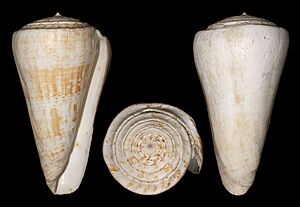Conus pulcher facts for kids
Quick facts for kids Conus pulcher |
|
|---|---|
 |
|
| A shell of Conus pulcher | |
| Conservation status | |
| Scientific classification | |
| Synonyms | |
|
The Conus pulcher, also known as the butterfly cone, is a type of sea snail. It's a marine gastropod mollusk, which means it's a snail that lives in the ocean and has a shell. It belongs to the family Conidae, often called the cone snails.
Like all species in the Conus group, these snails are predatory. This means they hunt other small sea creatures for food. They are also venomous. Because of their venom, it's important to be very careful around live cone snails. It's best not to touch them at all.
There is one known subspecies of the butterfly cone: Conus pulcher siamensis, described by Hwass in Bruguière in 1792.
What Does the Butterfly Cone Look Like?
The shell of the butterfly cone can be quite large. It usually measures between 40 mm (about 1.5 inches) and 260 mm (about 10 inches). This makes it the largest of all the cone snails!
The shell is narrow and somewhat thin. It has fine lines running lengthwise along its surface. The top part of the shell, called the spire, is pointed and has grooves. The shell's color can vary from white to cream. It often has many lines of short dashes and spots that range from light to dark brown.
Where Do Butterfly Cones Live?
You can find the Conus pulcher in the Eastern Atlantic Ocean. They live off the coasts of countries like Guinea, Senegal, and Angola in Africa.
Images for kids
-
A shell of albinistic (white) and regular color, both with their outer skin (periostracum).



